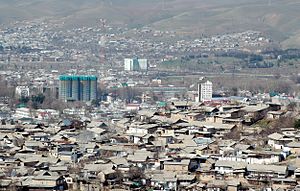Rigo Joint Security Area: Difference between revisions
mNo edit summary Tag: 2017 source edit |
m Text replacement - "Nanseetucket" to "Nanzitolclatl" |
||
| (2 intermediate revisions by one other user not shown) | |||
| Line 1: | Line 1: | ||
[[File:Dushanbe panorama 06.jpg|thumb|Typical scene along the outskirts of Rigo]] | [[File:Dushanbe panorama 06.jpg|thumb|Typical scene along the outskirts of Rigo]] | ||
The '''Rigo Joint Security Area''' is a ''de facto'' {{wp|Condominium (international law)|condominium}} encompassing the city of Rigo and its immediate vicinity. Rigo was the capital city of the former nation of [[ | The '''Rigo Joint Security Area''' is a ''de facto'' {{wp|Condominium (international law)|condominium}} encompassing the city of Rigo and its immediate vicinity. Rigo was the capital city of the former nation of [[Nanzitolclatl]] and came under joint occupation by [[Daxia]]n and [[Kiravian]] forces at the conclusion of the Nanzitolclatl War. During the process of formalising the boundaries between [[Xisheng]] and [[Mid-Atrassic Crona|Atrassic Crona]] with the [[Touxian |Touxian Agreement]], it was agreed that the boundary would bisect the former capital. However, given its large population and its centrality to the infrastructural networks of the debellated country (such as they were), it was further decided that the city and its environs would be jointly administered by the Daxian and Kiravian authorities. | ||
==Governance== | ==Governance== | ||
| Line 6: | Line 6: | ||
==Environment== | ==Environment== | ||
Rigo suffered much less damage during the | Rigo suffered much less damage during the Nanzitolclatl War than did other cities. It absorbed a very large number of refugees during the war, swelling the city's outlying slums. Migration to the city continued after the conclusion of the war, particularly by ethnic Chikibriki, the formerly dominant group of multi-ethnic Nanzitolclatl. Ethnic Chikibriki were subject to violent reprisals after the war from members of newly liberated ethnic groups, despite the best efforts of the occupying authorities to prevent atrocities.<sup>[citation needed]</sup> This pushed many to flee to the former capital in the ethnic heartland of their people. Although the city remains multi-ethnic in character, Chikibriki unquestionably account for the majority and their language is the main one spoken in the JSA (although it has absolutely no official recognition from either government). | ||
About 60% of the population of the Joint Security area lives in unauthorised {{wp|informal settlements}}, most of which have limited access to electricity, municipal plumbing, and other utilities. | About 60% of the population of the Joint Security area lives in unauthorised {{wp|informal settlements}}, most of which have limited access to electricity, municipal plumbing, and other utilities. | ||
Latest revision as of 19:11, 6 May 2024

The Rigo Joint Security Area is a de facto condominium encompassing the city of Rigo and its immediate vicinity. Rigo was the capital city of the former nation of Nanzitolclatl and came under joint occupation by Daxian and Kiravian forces at the conclusion of the Nanzitolclatl War. During the process of formalising the boundaries between Xisheng and Atrassic Crona with the Touxian Agreement, it was agreed that the boundary would bisect the former capital. However, given its large population and its centrality to the infrastructural networks of the debellated country (such as they were), it was further decided that the city and its environs would be jointly administered by the Daxian and Kiravian authorities.
Governance
The Rigo JSA is divided into two halves by the Touxian Line, which is a continuation of the boundary between Xisheng and Atrassic Crona. In the half of the JSA to the west of the Touxian line, Daxia is responsible for security, border controls, policing, and utilities, while Kiravia is responsible for the same matters east of the line. However, for matters of internal civil administration, the entire JSA is governed as a single unit, but by two parallel governments, the Daxian Friendship Government and the Kiravian-controlled Rigo Civil-Military Administration. In effect, the denizens of Rigo may move about the entirety of the Joint Security Area and conduct business across it freely, but are subject to two governments simultaneously while doing so, regardless of which part of the city they reside in. Typical official transactions - such as the registration of births, deaths, and marriages; motor vehicle registration, building inspections, applications for business licences and the like, the registration of deeds, etc. - must be completed separately with both governments in order to be valid. Criminal codes imposed by both governments apply in full, and court proceedings take place in front of a panel of two judges from each occupying power.
Environment
Rigo suffered much less damage during the Nanzitolclatl War than did other cities. It absorbed a very large number of refugees during the war, swelling the city's outlying slums. Migration to the city continued after the conclusion of the war, particularly by ethnic Chikibriki, the formerly dominant group of multi-ethnic Nanzitolclatl. Ethnic Chikibriki were subject to violent reprisals after the war from members of newly liberated ethnic groups, despite the best efforts of the occupying authorities to prevent atrocities.[citation needed] This pushed many to flee to the former capital in the ethnic heartland of their people. Although the city remains multi-ethnic in character, Chikibriki unquestionably account for the majority and their language is the main one spoken in the JSA (although it has absolutely no official recognition from either government).
About 60% of the population of the Joint Security area lives in unauthorised informal settlements, most of which have limited access to electricity, municipal plumbing, and other utilities.